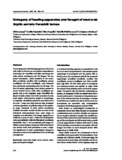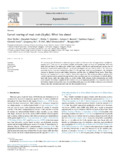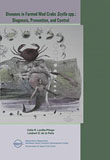Ontogeny of feeding apparatus and foregut of mud crab Scylla serrata Forsskål larvae
- Global styles
- MLA
- Vancouver
- Elsevier - Harvard
- APA
- Help

ดู/
วันที่
2007ผู้เขียน
Page views
1,629ASFA keyword
AGROVOC keyword
Taxonomic term
เมตาดาต้า
แสดงระเบียนรายการเต็ม
Share
นามธรรม
The development of the feeding apparatus of the mud crab Scylla serrata larvae was studied using electron microscopy for mandibles and light microscopy for other paired mouthparts and the foregut. The six paired mouthparts, which consisted of the mandibles, maxillules, maxillae, first maxillipeds, second maxillipeds and third maxillipeds, were dissected from specimens representing each larval stage. The first five paired appendages were already present in newly hatched larvae while third maxillipeds appeared only at the megalopa stage. Mandibles displayed complex incisor and molar processes at early zoeal stages, which became simple in morphology at megalopa. Mandibular palp buds were observed at the zoea 5 stage and these became fully developed as three-segmented mandibular palps at the megalopa stage. Endopods of other paired mouthparts exhibited increased number of setae and size as the individual metamorphosed from zoeal stages to megalopa and crab instar. The foregut appeared as a continuous cavity at zoea 1 where the cardiopyloric valve was indistinct while the filter gland was clearly identifiable. Zoea 2 and succeeding zoeal stages exhibited a setose foregut; the gastric mill and its lateral and median teeth were prominent at zoea 3 stage. The significance of these morphological changes is discussed in terms of its implication in larval feeding management.
Keywords
mud crab Scylla serrata larvae ontogeny mouthparts foregutการอ้างอิง
Lumasag, G. J., Quinitio, E. T., Aguilar, R. O., Baldevarona, R. B., & Saclauso, C. A. (2007). Ontogeny of feeding apparatus and foregut of mud crab Scylla serrata Forsskål larvae. Aquaculture Research , 38(14), 1500-1511. https://doi.org/10.1111/j.1365-2109.2007.01795.x
Type
ArticleISSN
1365-2109คอลเลกชัน
- Journal Articles [1258]
Related items
Showing items related by title, author, creator and subject.
-
Larval rearing of mud crab (Scylla): What lies ahead
Waiho, Khor; Fazhan, Hanafiah; Quinitio, Emilia T. ; Baylon, Juliana C.; Fujaya, Yushinta; Azmie, Ghazali; Wu, Qingyang; Shi, Xi; Ikhwanuddin, Mhd; Ma, Hongyu (Elsevier, 2018)
The increasing global demand for mud crabs (genus Scylla) and threats to the wild populations highlight the urgency of fully rearing them in captivity. Despite considerable progress in mud crab production, most crab farms ...
; Baylon, Juliana C.; Fujaya, Yushinta; Azmie, Ghazali; Wu, Qingyang; Shi, Xi; Ikhwanuddin, Mhd; Ma, Hongyu (Elsevier, 2018)
The increasing global demand for mud crabs (genus Scylla) and threats to the wild populations highlight the urgency of fully rearing them in captivity. Despite considerable progress in mud crab production, most crab farms ... -
Diseases in farmed mud crabs Scylla spp.: Diagnosis, prevention, and control.
Lavilla-Pitogo, Celia R.; de la Peña, Leobert D. (Aquaculture Dept., Southeast Asian Fisheries Development Center, 2004-12)Aquaculture production has suffered many set-backs due to the occurrence of diseases. Many of the diseases are caused by infectious organisms that are difficult to detect and need sophisticated instruments for diagnosis, ... -
Mud crab pond and pen culture
Rodriguez, Eduard M. (University of the Philippines Aquaculture Society, Inc, 2001)




